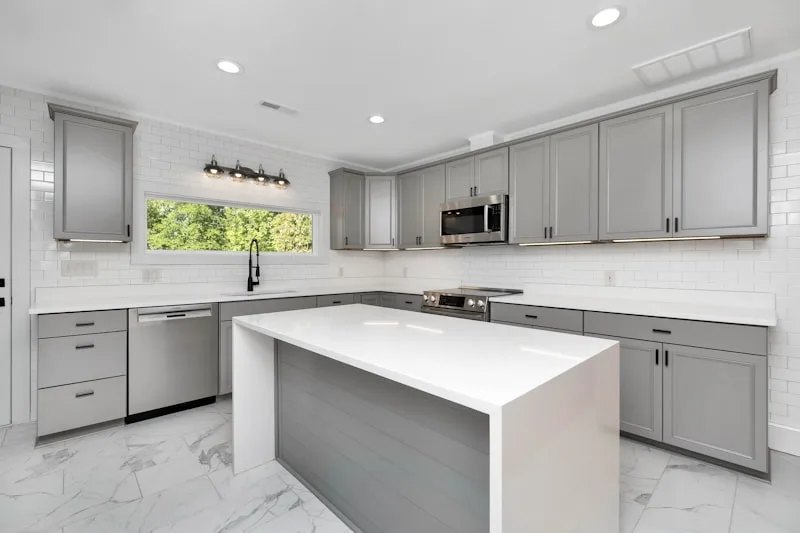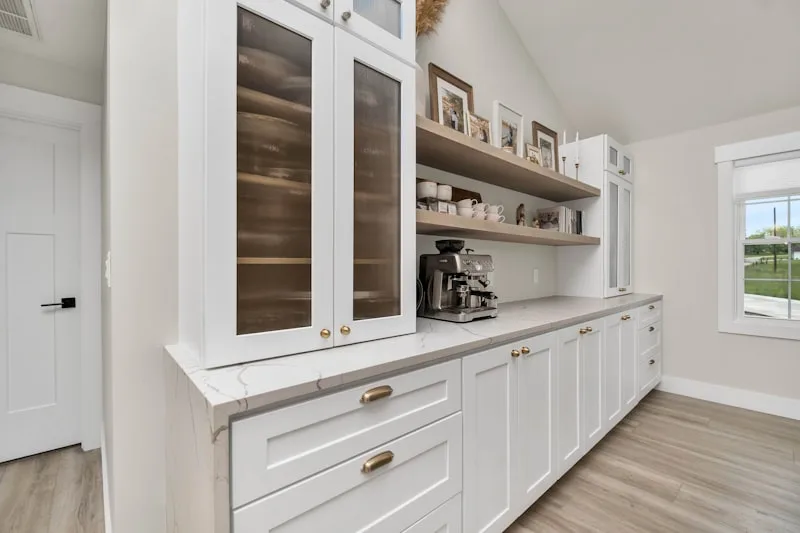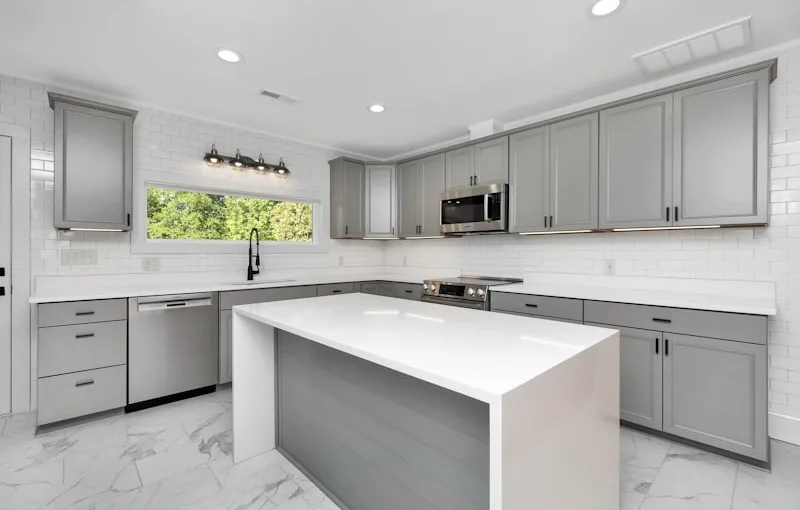First things first, gather your tools. You’ll need a screwdriver, a drill, and maybe a pry bar if things get stubborn. Think of these tools as your trusty sidekicks on this DIY adventure. Before you dive in, clear out everything from the cabinets. It’s like packing for a trip; you don’t want to leave anything behind that could weigh you down!
Next, locate the screws that hold the cabinets to the wall. They’re usually found on the underside of the cabinet or on the sides. If you can’t find them, don’t panic! A little exploration with your screwdriver will usually reveal their hiding spots. Once you’ve unscrewed them, gently pull the cabinet away from the wall. It’s like peeling a banana—just be careful not to squish it!
If the cabinet seems stuck, it might be glued or caulked in place. In that case, a pry bar can help you gently coax it off. Just remember, patience is key here. You don’t want to damage your walls or the cabinets if you plan to reuse them.
As you work, keep an eye out for any electrical or plumbing fixtures that might be lurking behind the cabinets. It’s like a treasure hunt, but you definitely don’t want to hit a hidden wire! Once you’ve successfully removed the cabinet, take a moment to admire your handiwork. You’re one step closer to transforming your kitchen into the space of your dreams!
DIY Delight: A Step-by-Step Guide to Removing Your Kitchen Cabinets

First things first, gather your tools. You’ll need a screwdriver, a drill, a pry bar, and maybe a friend to help you out. It’s always more fun to tackle a project with a buddy, right? Before you start, clear everything out of your cabinets. Think of it as decluttering your mind before a big exam—everything needs to be out of the way for a fresh start.
Now, let’s get to the nitty-gritty. Begin by removing the cabinet doors. Unscrew the hinges and set the doors aside. It’s like taking off a jacket before a workout—much easier to move around! Once the doors are off, it’s time to tackle the shelves. If they’re adjustable, just lift them out. If they’re fixed, you might need to unscrew them too.
Next, it’s time to detach the cabinets from the wall. Start with the screws that hold them in place. This is where your drill comes in handy. As you unscrew, think of it as untying a knot—just a little twist and pull, and you’re on your way! If the cabinets are stubborn, a pry bar can help gently nudge them away from the wall.
Once they’re free, carefully lower them down. It’s like a dance—smooth and steady. And voilà! You’ve just removed your kitchen cabinets! Now, take a moment to admire your handiwork. You’re one step closer to that dream kitchen makeover!
Unlocking Your Kitchen’s Potential: How to Safely Take Off Cabinets
First off, think of your cabinets as the protective shell of your kitchen. Removing them is like peeling back the layers of an onion; it reveals the potential hidden underneath. But just like with any renovation, you want to avoid tears! Start by emptying your cabinets completely. This not only lightens the load but also gives you a chance to declutter. Who knew you had that many mismatched mugs?
Next, it’s time to gather your tools. You’ll need a screwdriver, a drill, and maybe a friend or two—because let’s be honest, lifting heavy cabinets is a two-person job. Before you start unscrewing, make sure to turn off any electrical outlets or lighting fixtures attached to the cabinets. Safety first, right?
Once you’re ready, begin by removing the doors. This makes the cabinets lighter and easier to handle. After that, unscrew the cabinets from the wall. If they’re stubborn, a gentle nudge with a pry bar can help, but be careful not to damage the walls. Think of it like coaxing a shy cat out from under the bed—patience is key!
From Drab to Fab: The Ultimate Guide to Cabinet Removal for a Kitchen Makeover
First things first, let’s talk about the thrill of cabinet removal. It’s like peeling off an old layer of paint to reveal a vibrant canvas underneath. You might be wondering, “Is it really that easy?” Well, with the right tools and a bit of elbow grease, you can absolutely do it yourself! Grab a screwdriver, a pry bar, and some safety goggles, and you’re ready to roll. Just think of it as a mini workout—who doesn’t love a little sweat equity?

Now, picture this: once those old cabinets are out, you’ll have a blank slate to work with. It’s like standing in front of a giant canvas, ready to create your masterpiece. You can opt for open shelving, sleek modern cabinets, or even a rustic farmhouse vibe. The possibilities are endless! Plus, removing those bulky cabinets can make your kitchen feel more spacious and airy, almost like a breath of fresh air.
Cabinet Removal 101: Tips and Tricks for a Smooth DIY Project
First things first, gather your tools. You’ll need a drill, a screwdriver, a pry bar, and maybe even a friend to lend a hand. Trust me, having an extra set of hands can turn a daunting task into a fun bonding experience. Imagine trying to juggle all those tools while balancing on a ladder—yikes!
Before you dive in, clear out the cabinets. It’s like decluttering your mind before a big exam. You want to make sure you have a clean slate to work with. Plus, it’ll save you from the chaos of dodging dishes and pots while you’re trying to unscrew everything.
Now, let’s talk about the actual removal. Start by unscrewing the cabinet doors. It’s like taking off a jacket before a workout—much easier to move around! Once the doors are off, locate the screws that hold the cabinet to the wall. If you’re feeling adventurous, you can even use a pry bar to gently coax the cabinet away from the wall. Just be careful; you don’t want to damage your drywall.
And here’s a pro tip: if you’re dealing with upper cabinets, always work from the top down. It’s like stacking blocks—remove the top ones first to avoid a domino effect.
Lastly, don’t forget to celebrate your hard work! Whether it’s a high-five with your buddy or a slice of pizza, you deserve it. After all, you’ve just taken a big step toward transforming your space!
Frequently Asked Questions
How Long Does It Take to Remove Kitchen Cabinets?
The time required to remove kitchen cabinets typically ranges from 2 to 6 hours, depending on the complexity of the installation, the number of cabinets, and the experience of the person doing the removal. Proper preparation and tools can help streamline the process.
What Should I Do After Removing My Kitchen Cabinets?
After removing your kitchen cabinets, assess the condition of the walls and flooring for any necessary repairs. Clean the area thoroughly to remove dust and debris. Plan your next steps, whether it’s installing new cabinets, painting, or updating the kitchen layout. Ensure all plumbing and electrical work is addressed before proceeding with renovations.
Are There Any Tips for Removing Kitchen Cabinets Without Damage?
To remove kitchen cabinets without causing damage, start by emptying the cabinets and removing any hardware. Use a screwdriver to detach the cabinets from the wall and each other, taking care to support them as you work. A pry bar can help gently loosen any stubborn areas. Always work slowly and carefully to avoid damaging the walls or the cabinets themselves.
How Do I Safely Remove Kitchen Cabinets?
To safely remove kitchen cabinets, start by emptying all contents and removing any hardware. Turn off power to any electrical components and disconnect plumbing if necessary. Use a stud finder to locate and mark the screws or nails securing the cabinets to the wall. Carefully unscrew or pry them off, starting from the top and working your way down. Ensure to support the cabinets as you remove them to prevent injury or damage.
What Tools Do I Need to Take Off Kitchen Cabinets?
To remove kitchen cabinets, you will need a few essential tools: a screwdriver (preferably a power drill for efficiency), a pry bar for leverage, a level to ensure proper alignment during reinstallation, and safety goggles to protect your eyes. Additionally, a stud finder can help locate screws hidden in the wall, and a measuring tape is useful for accurate measurements. Having these tools ready will make the process smoother and more efficient.
